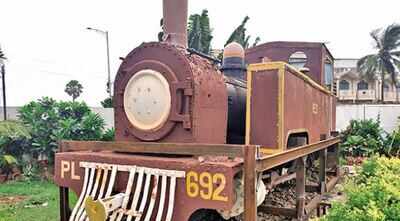- News
- City News
- bhubaneswar News
- Historian draws rlys’ attention to heritage engine lying in neglect
Historian draws rlys’ attention to heritage engine lying in neglect

The rusty train engine at BNR Hotel in Puri
BHUBANESWAR: Conservationist and historian Anil Dhir has expressed concern over the neglected heritage railway steam engine — PL-692 — kept in front of the BNR Hotel in Puri. He has urged the Railways to give a fresh coat of paint to the century-old engine to prevent it from rusting further.
He said, “The saline air of the place has damaged the engine, while the rust has corroded it completely. The roof of the engine has withered away. Several layers of rust have formed on the boiler, wheels and chimney. I request the Indian Railways to preserve it in the upcoming rail museum at Bhubaneswar.” He added that this old engine was featured in one of the postage stamps issued during the 1987 centenary celebrations of the South Eastern Railway.
The century-old railway locomotive was imported by the Maharaja of Paralakhemundi for Rs 12,000 then. It was run by the Parlakimedi Light Railway (PLR). The Paralakhemundi engine known as PL class was built by Kerr, Stuart and Company of England in 1904. The engine weighs 20 tonnes. It was run on a 2-feet-6-inch gauge of PLR in the Naupada-Gunupur section (90.6km).
The Railways had brought the rail lines to Naupada in 1884. The then Maharaja of Parlakimedi (now Paralakhemundi) had decided to connect his capital Paralakhemundi with Naupada with a light railway and had approached the government for its sanction to the proposal. After getting permission for the light railway in 1898, the Maharaja of Paralakhemundi had opened a 39km line on April 1, 1900 by spending Rs 7 lakh.
After the Indian Railways Act, 1890, came into force to this line, the Bengal Nagpur Railway (BNR) had taken over the PLR from January 1, 1902. Initially, this line was making losses. After 1910, it had started making marginal profits, which increased after 1924-25. Later, the line was extended to Gunupur by 1931.
He said, “The saline air of the place has damaged the engine, while the rust has corroded it completely. The roof of the engine has withered away. Several layers of rust have formed on the boiler, wheels and chimney. I request the Indian Railways to preserve it in the upcoming rail museum at Bhubaneswar.” He added that this old engine was featured in one of the postage stamps issued during the 1987 centenary celebrations of the South Eastern Railway.
The century-old railway locomotive was imported by the Maharaja of Paralakhemundi for Rs 12,000 then. It was run by the Parlakimedi Light Railway (PLR). The Paralakhemundi engine known as PL class was built by Kerr, Stuart and Company of England in 1904. The engine weighs 20 tonnes. It was run on a 2-feet-6-inch gauge of PLR in the Naupada-Gunupur section (90.6km).
The Railways had brought the rail lines to Naupada in 1884. The then Maharaja of Parlakimedi (now Paralakhemundi) had decided to connect his capital Paralakhemundi with Naupada with a light railway and had approached the government for its sanction to the proposal. After getting permission for the light railway in 1898, the Maharaja of Paralakhemundi had opened a 39km line on April 1, 1900 by spending Rs 7 lakh.
After the Indian Railways Act, 1890, came into force to this line, the Bengal Nagpur Railway (BNR) had taken over the PLR from January 1, 1902. Initially, this line was making losses. After 1910, it had started making marginal profits, which increased after 1924-25. Later, the line was extended to Gunupur by 1931.
FacebookTwitterLinkedinEMail
Start a Conversation
end of article
Top Stories Right Now
- sportsOlympics live: India erupts in joy as men's hockey team wins bronze
- sportsMeet Indian men's hockey team which broke a 41 year medal jinx
- congratulate-indian-hockey-team-for-winning-bronze-medalCongratulate Indian hockey team for winning bronze medal
Quick Links
Delhi Air PollutionDelhi TemperatureChennai WeatherBangalore TemperatureCovid vaccination centres in DelhiCoronavirus in DelhiRTPCR test in GurgaonHyderabad RainPollution level in BangaloreDelhi SmogDelhi TemperatureNoida AQIGurgaon AQI todayFire in MumbaiMumbai RainsCovid 19 RT PCR Test in NoidaDelhi AQI todaySrinagar encounter

